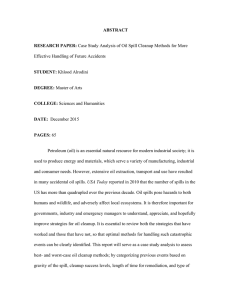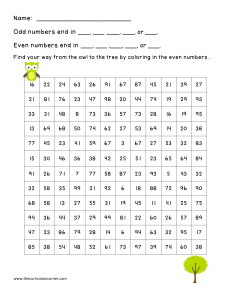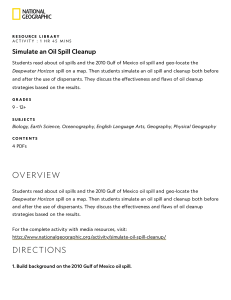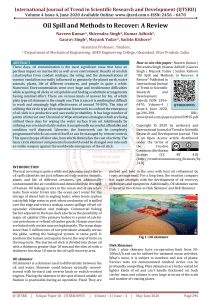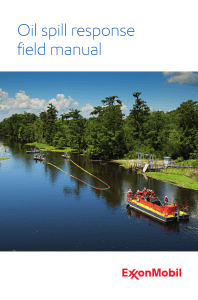Oil Spill Cleanup lab
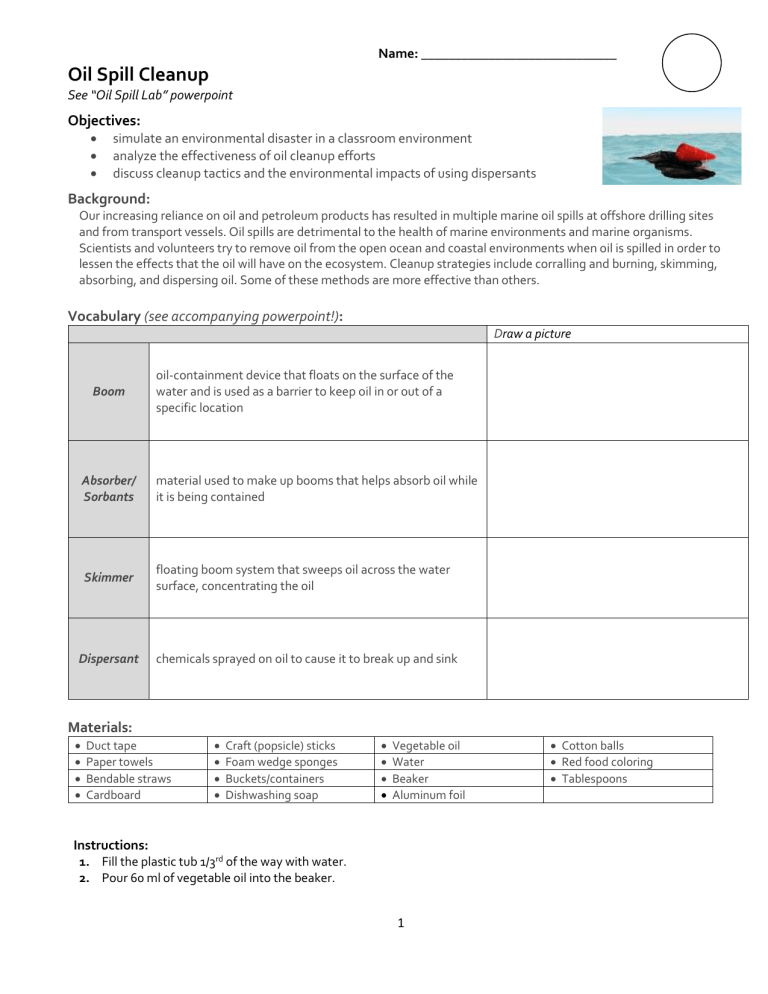
Name: _____________________________
Oil Spill Cleanup
See “Oil Spill Lab” powerpoint
Objectives:
simulate an environmental disaster in a classroom environment
analyze the effectiveness of oil cleanup efforts
discuss cleanup tactics and the environmental impacts of using dispersants
Background:
Our increasing reliance on oil and petroleum products has resulted in multiple marine oil spills at offshore drilling sites and from transport vessels. Oil spills are detrimental to the health of marine environments and marine organisms.
Scientists and volunteers try to remove oil from the open ocean and coastal environments when oil is spilled in order to lessen the effects that the oil will have on the ecosystem. Cleanup strategies include corralling and burning, skimming, absorbing, and dispersing oil. Some of these methods are more effective than others.
Vocabulary (see accompanying powerpoint!):
D raw a picture
Boom
Absorber/
Sorbants
Skimmer oil-containment device that floats on the surface of the water and is used as a barrier to keep oil in or out of a specific location material used to make up booms that helps absorb oil while it is being contained floating boom system that sweeps oil across the water surface, concentrating the oil
Dispersant chemicals sprayed on oil to cause it to break up and sink
Materials:
Duct tape
Paper towels
Bendable straws
Cardboard
Craft (popsicle) sticks
Foam wedge sponges
Buckets/containers
Dishwashing soap
Vegetable oil
Water
Beaker
Aluminum foil
Cotton balls
Red food coloring
Tablespoons
Instructions:
1.
Fill the plastic tub 1/3 rd of the way with water.
2.
Pour 60 ml of vegetable oil into the beaker.
1
2.
3.
4.
3.
Put 3 drops of food coloring into the oil. Mix with the wooden stick as well as possible. (The coloring will not mix in completely.) The oil represents crude oil. The food coloring represents chemicals trapped inside of the
oil.
4.
Slowly pour the oil into the center of the water.
5.
Make a small foil “boat” (about an inch wide) and float it in the middle of the oil spill. When you attempt your cleanups, you must try to not capsize the boat.
6.
Choose five of the supplied clean-up materials one at a time to try to remove the oil before it reaches the side of the container. One data collector should keep track of the materials used on the data table and the group needs to decide if each should be designated a boom, skimmer or absorber. Feel free to add more oil if any of the materials are successful in removing all the oil. Fill out Data Table 1.
Data Table 1: Before Dispersants
Type of Material Material’s Role
Effectiveness Rating
1-5
(5 = most effective; all oil and chemicals removed)
Observations
1.
(Boom/Skimmer/
Absorber)
5.
After you have tried all the materials, add a few drops of dishwashing liquid to the middle of the oil spill. This is the
dispersant. Answer the questions below.
What happened to the oil? Why?
What happened to the chemicals (dye)? Why?
What color is the water? Why?
7.
Re-test 3 materials on the oil spill and fill out Data Table 2. Answer the analysis questions.
Data Table 2: After Dispersants
Type of Material Material’s Role
(Boom/Skimmer/
Absorber)
Effectiveness Rating
1-5 (5 = most effective; all oil and chemicals removed)
Observations
2
1.
2.
3.
Analysis Questions
1.
Summarize the efficacy of the different cleanup strategies. Did you combine any of them?
2.
What are some advantages to using dispersant? Consider both the lab simulation and real life.
3.
What are some of the negative impacts of dispersants? Consider both the lab simulation and real life.
3


